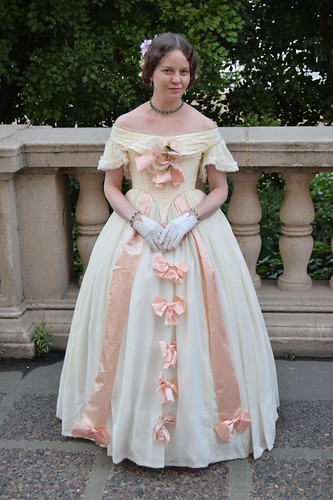
I hadn't even planned on making a new ball gown for Gettysburg Remembrance Day in 2015. I have several 1850s and 1860s ball gowns that I love. However, while looking for wool plaid, I came across wool gauze at Farmhouse Fabrics, and my plans immediately changed. Wool gauze is one of those fabrics that has mostly disappeared to time, and there was no way I could pass it up!
I've worn this dress three times--to the Gettysburg ball, the Victorian Grand Ball in Pasadena, and to Costume College 2016.
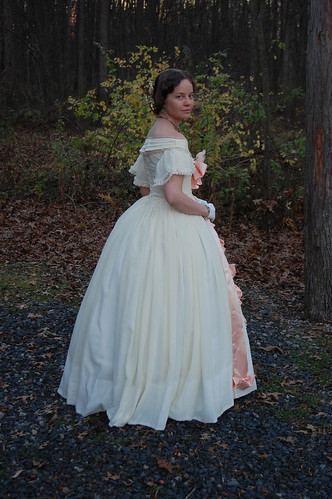

Unfortunately, the only construction picture I have is the finished bodice point. I loathe making points, so it was an accomplishment! I had hit that time before an event where everything just needs to get done. It follows basic mid-century techniques though. It's flatlined with polished cotton from Needle and Thread and the edges are finished with narrow piping. The skirt is set with cartridge pleats on a straight waistband and basted to the bodice. It's trimmed with 4 inch silk rayon vintage ribbon from eBay, narrow silk ribbon from Farmhouse Fabrics, and self pleated trim. The bertha is a separate piece, and made of one wide piece of wool gauze pleated to fit. It closes over the left shoulder. The bodice laces up the back with spiral lacing, based on this bodice that belonged to the Empress Eugenie. The flower on the bodice is from A Pink Swan on Etsy. My necklace, bracelets, earrings, and paper flowers in my hair are from Dames a la Mode.
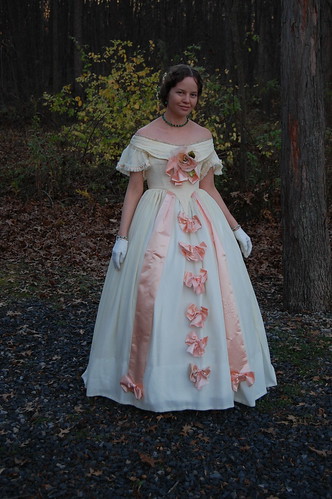
I do have some rather period correct damage to the dress. You'll notice that in this picture, the ribbon streamers are the same length, while the one on my right is a little longer in the first picture. I was flung during the ball in Gettysburg (where this picture was taken) and one ribbon ripped. It was thankfully right up top, so the repair was easy to hide!
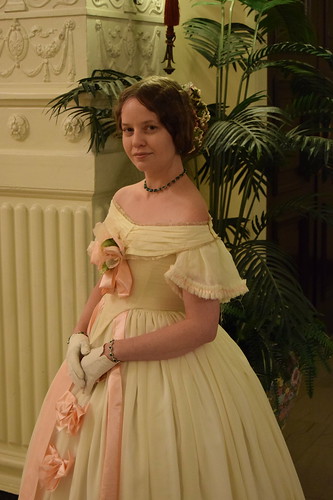
I always find proportions to be one of the most important things in costuming. 1860s ball gown necklines typically sit on the point of the shoulder and angle slightly down to the center front. Because I'm so small, I find that to get the overall period looking line, I need to make the neckline a little lower. If I don't, the bodice sits too high on my chest, and doesn't give the correct look.
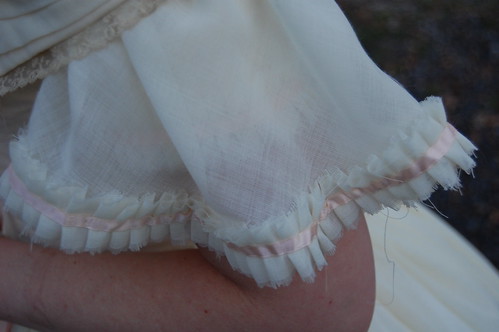
The pleating on the sleeves is made of unhemmed straight strips of fabric. I wanted to keep the lightness. The wool is very sheer, and you can see the shadow of the tight sleeve, which is trimmed the same way, under the loose sleeve.
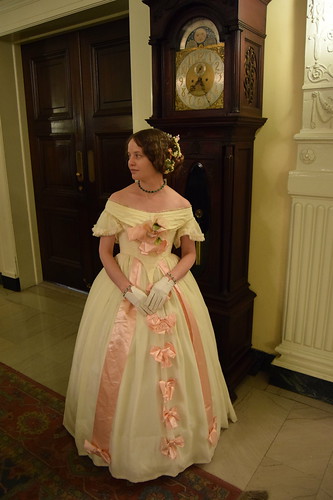

The Masonic Temple in Pasadena is a lovely backdrop for period gowns!

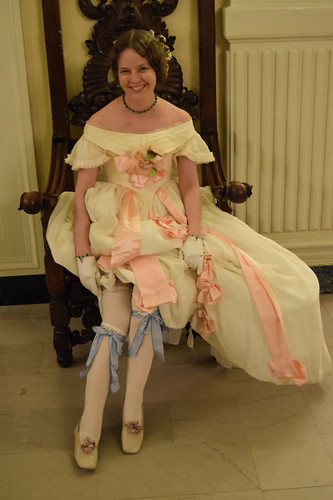
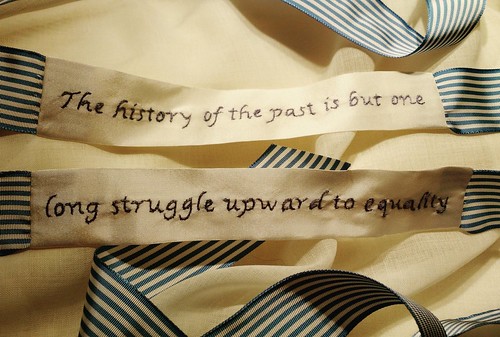
My not period correct garters are a quote by Elizabeth Cady Stanton--The history of the past is but one long struggle upward to equality--something that sounds so much less true than when I made them.
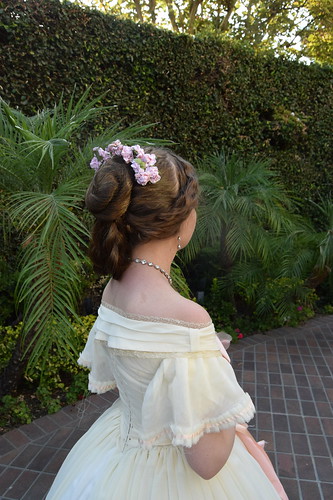
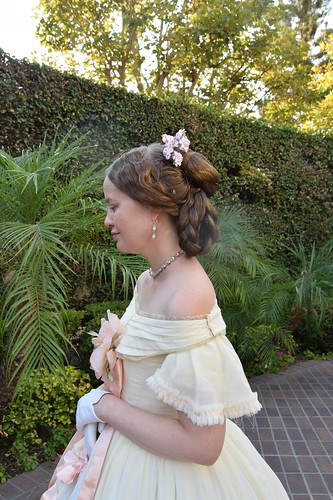
I wore a different hairpiece at Costume College. During the day I wore my Regency version of Princess Leia's Bespin dress, and that hairpiece worked remarkably well for the 1860s!
The fabric on the dress is incredibly light and airy. It's so much fun to dance in :)

Absolutely stunning! Is wool gauze hard to sew? Does it rip easily? How did you make the bertha-strips of bias tape, or one large piece folded in pleats?
ReplyDeleteThank you!
DeleteThe wool gauze was easy to sew. I sewed the unlined pieces by hand so it didn't shift around too much, and the polished cotton lining supported it when I machine sewed the rest.
It rips very easily.
The bertha is folded into pleats. It's sheer enough that bias strips wouldn't look good--the seam allowances would show through.
Both you and the dress look so lovely!
ReplyDeleteThank you!
Deletedreamlike dress. I love the bows and the width of the skirt. Beautiful hair and decoration
ReplyDeletehave a nice day
gusta
Thank you, and you as well!
DeleteI love that you tried working with wool gauze for a ball gown; I always hear that it's correct but I don't think I've ever seen anyone actually use. I will need to keep an eye on that vendor.
ReplyDeleteI really love your skirt silhouette; it's conservative-sized, but still so floofy! Do you mind sharing what sort of hoop/petticoats you have on underneath?
Thank you!
DeleteI feel very lucky to have found the fabric. It's not at all common anymore!
I'm wearing the 95" Needle and Thread hoop (http://www.woodedhamlet.com) and a petticoat made of a crisp cotton. It's just straight panels stroke gathered to the waistband. Very straightforward :)
This is so so pretty and so lovely on you. All 3 1860s gowns really suit you in style. I enjoyed seeing the pics and everything in one place! This one is one I particularly want to steal, if only we were the same size! ;-) Beautiful work!
ReplyDeleteThis is so lovely! I have no idea what I'm doing with regards to Victorian gowns, but one is on my future projects list! lol I foresee lots of bad words and seam ripping once I get started...but this is such a fun, beautiful gown, I'm feeling inspired ;)
ReplyDeletedreamlike dress. I love the bows and the width of the skirt. Beautiful hair and decoration
ReplyDeleteโกเด้นสล็อต
Gclub casino online
ReplyDeleteBeautiful, the dress and the owner. One doubt, being wool, does it shrink a lot? I imagine you will need dry cleaning.
This comment has been removed by the author.
ReplyDeleteThis dress is sooo dreamy! :) Lovely!
ReplyDeleteI was do pleased to find this, as I am getting ready to make my first CW period silk dress with both a day bodice and ball gown bodice, and I wanted to trim it similarly. Though my silk is a delicate pastel plaid, I wanted to dress it up with a ribbon ending in a bow on each seam, so eight. Would it be wrong to stitch the ribbons to the fabric all the way down from waist to bow to prevent them from catching on things?
ReplyDelete